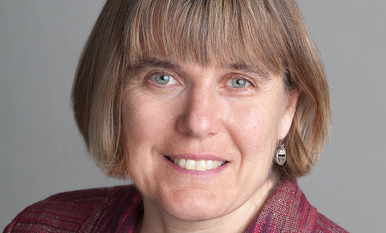Finding Resilience and Hope in Apocalyptic Times: A Q&A with Barbara Rossing
September 26, 2017 •
What is the topic of your Enhancing Life research? Has there been anything recently in the news that's struck you as relevant to your topic?
My topic is hope for the future--"eschatology"-- and how the Bible can help us shape authentic hope. I am especially interested in how eschatology can address the issue of climate change. I draw on traditional teaching and also try to find new angles on familiar biblical stories. There's a story of healing in the Gospel of Mark, for example, where a father uses the word "eschatos" to describe his desperately ill daughter to Jesus, "My daughter is at the eschatos” (Mark 5:23). Come heal her!” Eschatos means the “end” or “ultimate.” It also means the edge, the brink. “At the point of death” is how English translations typically translate the reference. We and the biosphere, like the daughter, are at the point of death—the eschatos. We need healing!
News stories of weather disasters intensified by global warming have hit us all recently: Hurricanes Harvey and Irma with rains news reports described as "biblical"; the terrible Eagle Creek wildfire that jumped the Columbia River from Oregon into Washington; the news that two U.S. island villages have officially become the United States’ first "climate refugees"-- Isle de Jean Charles, home of the Biloxi-Chitimacha-Choctaw tribe in the Gulf of Mexico; and the village of Shishmaref, Alaska, a Lutheran Inupiat village I learned about growing up. Losing their island home for these villagers means losing their whole culture, their whole way of life. How do we transition to a different path before it is too late? One image is the Doomsday Clock--the scientists moving the hands closer to midnight--to try to raise a public sense of urgency. We definitely need the Doomsday Clock's wake-up call. We also need stories with images of hope--stories about the rapid advances in battery technology, stories about places where solar and wind power are now cheaper than coal or natural gas-generated electricity; stories that show us how a 100% renewable energy economy is possible and affordable right now. We need religious stories to offer positive signs of hope and resilience. There are so many great stories of communities and religious leaders making a difference, sowing seeds of hope.
What was your Enhancing Life Studies course about, and what did you learn from teaching this course?
I co-taught a doctoral seminar on eschatology and apocalyptic theology with Brazilian colleagueVítor Westhelle, a systematic theologian, author of the book Eschatology and Space: The Lost Dimension in Theology Past and Present, (Palgrave Macmillan, 2012). The class included the basics in terms of the history of eschatological thinking-- apocalyptic biblical texts, Augustine's City of God, Schweitzer, Bultmann, and a whole range of twentieth century theologians, including feminist and womanist theologians. We included a strong post-colonial and liberation focus, the ways eschatology can speak on behalf of marginalized and landless peoples living at the "eschatos" or edge today. Many of our PhD students at the Lutheran School of Theology are international students, so that global liberation focus spoke to them. While some of the students struggled to move beyond traditional thinking of eschatology---heaven or hell, where you go after you die-- most students really worked on questions of hope for their own contexts. We also included science and eschatology, drawing on resources of the Zygon Center for Religion and Science and others.